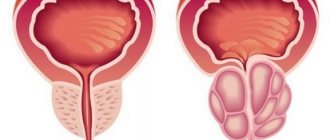Where is the epigastric region located and why does it bother you?
A healthy person hardly thinks about where the epigastric region is located, but when abdominal pain occurs, patients want to figure out how to find the epigastric region and correctly describe their condition to the doctor.
Moreover, when studying diseases of internal organs on the Internet, you can often see such a symptom as pain and discomfort in the epigastrium.
And how can a patient who does not understand the topography of organs and systems understand whether he has pain and discomfort in the epigastrium or not?
We suggest that you familiarize yourself with the concept of the epigastric region, understand its components and understand the symptoms of which diseases have a similar localization.
Topographic division of the abdominal cavity
The abdomen can be divided into 9 areas by drawing 4 specific lines. The first goes from the right costal arch to the left, the second - from one branch of the ilium to the other. The last 2 lines go vertically, located a few centimeters to the right and left of the navel, dividing the belly into 3 equal parts.
Topography of the abdominal regions
So we get 9 regions: right hypochondrium, epigastrium, left hypochondrium, right lateral, periumbilical region or mesogastrium, left lateral, right iliac, left iliac region and hypogastrium or suprapubic zone. The epigastric region is located in the center between both hypochondriums, and the lower part of the xiphoid process serves as the upper border.
Patients are also tormented by the question of where the epigastric region is located. The answer is simple: the epigastric zone and the epigastrium are synonyms.
Another definition states that the epigastrium is the area of projection of the stomach onto the anterior abdominal wall, which is also correct.
The following organs are located in the epigastric region:
- Stomach;
- duodenum;
- Left lobe of the liver;
- Gall bladder (partially localized in the epigastrium and partly in the right hypochondrium);
- Body of the pancreas.
Also, the epigastric region is sometimes called the solar plexus zone, which is the largest collection of nerve fibers. Therefore, pain in the epigastrium can be varied, radiate to other areas of the abdomen and back, and imitate diseases of other internal organs.
How are the main organs of the abdomen located?
Diseases of the epigastric region
Any disease of the epigastric region can cause pain, discomfort and other pathological sensations. The most common are:
- Gastritis;
- Gastric and duodenal ulcers;
- Complications of peptic ulcer: perforation, penetration, bleeding and others;
- Tumors of the epigastric organs;
- Pancreatitis, not necessarily affecting the body of the pancreas;
- Calculous cholecystitis;
- Enlarged liver during hepatitis, acute infections (the liver bothers the patient only in cases where it is enlarged, so hepatitis is often not accompanied by pain and discomfort in the abdomen).
Important: sometimes pain in the epigastric region may not be associated with diseases of the digestive system. For example, there are not isolated cases where myocardial infarction is accompanied by pain in the abdomen, namely in the epigastric region. This is due to the peculiarities of the innervation of the epigastrium and the reaction of the solar plexus.
In addition to myocardial infarction, pain in the epigastrium can appear due to lung diseases, namely pleurisy, lower lobe pneumonia and pneumothorax.
Types of epigastric pain
It is already clear that the most common unpleasant symptom in the epigastrium is pain, but the characteristics of pain can also be different, which allows the doctor to distinguish and suspect the pathology of a particular organ. And the patient needs to know what epigastrium is in order to correctly explain his feelings to a specialist.
- Constant dull, aching pain most often indicates gastritis;
- Hunger pain - the appearance of painful sensations at night or on an empty stomach speaks of a stomach or duodenal ulcer;
- The appearance or intensification of pain after eating may be a manifestation of gastritis or stomach cancer;
- A sharp, “dagger” pain indicates a perforation of the ulcer;
- Girdle pain that radiates to the subcostal areas and back is an important manifestation of pancreatitis.
Recommendation: Attempts to self-diagnose and relieve abdominal pain are not only ineffective, but also extremely dangerous. If the pain is acute and intense, you should call an ambulance, and for dull, aching, constant pain and low intensity, plan a scheduled visit to a specialist over the next few days.
Other symptoms of abdominal pathologies
In addition to pain, diseases of the epigastric region are manifested by other symptoms, the combination of which also directs the specialist to make the correct diagnosis.
- Gastritis, stomach ulcer, duodenal ulcer. In addition to pain, these pathologies are accompanied by nausea, often in the morning.
- Perforation of the ulcer, in addition to the sudden onset of pain, leads to tension in the abdominal muscles and a slowing of the pulse. Pallor and weakness also appear, and the patient may lose consciousness. This life-threatening condition requires emergency treatment.
- Bleeding from an ulcer is accompanied by an interesting symptom - the disappearance of abdominal pain. However, instead, pallor, weakness, blood in the stool (black feces), nausea, and vomiting blood appear.
- Pancreatitis, in addition to the characteristic girdle pain, is accompanied by nausea and vomiting. Also, inflammation of the pancreas disrupts intestinal motility, so there is no rumbling in the stomach and constipation appears.
- Calculous cholecystitis is manifested by pain in the epigastrium and right hypochondrium, which intensifies with coughing. Nausea, fever, and jaundice occur.
- Neoplasms, especially malignant pathologies, may not manifest themselves for a long time. In addition, cancer has no specific manifestations, except that the symptoms of internal organ disease are accompanied by constant weakness, fever, sweating, and decreased performance.
Methods for diagnosing organ pathologies
Having collected complaints and anamnesis of the disease, the doctor palpates the abdomen and performs some diagnostic manipulations, which are implemented thanks to knowledge about the peculiarities of the innervation of the abdominal organs. For example, when pressing on the xiphoid process, pain in the right hypochondrium intensifies, which indicates acute cholecystitis.
Interesting: in classic cases, pain with appendicitis begins in the epigastrium, and then descends to the right iliac region. This symptom is important in the diagnosis of appendicitis.
Next, a general blood test, a study of liver parameters, and a urine test are prescribed. These are mandatory diagnostic measures to determine the condition of the body and identify inflammation. Then, depending on the data obtained and existing symptoms, special examinations are prescribed to confirm a particular diagnosis.
- Determination of pancreatic enzymes in the blood allows to confirm acute pancreatitis;
- Ultrasound of the pancreas provides comprehensive data on the nature, location and severity of inflammation;
- Ultrasound examination of the gallbladder makes it possible to identify stones for the diagnosis of calculous cholecystitis or to detect thickening of its walls in acalculous cholecystitis;
- Ultrasound of the liver allows you to detect its enlargement and identify possible causes (cysts, helminthic infestations, inflammation, bile stagnation and others);
- Ultrasound of the abdominal organs also makes it possible to detect a tumor;
- X-ray of the abdominal organs reveals free gas under the right dome of the diaphragm - the main diagnostic sign of a perforated ulcer;
- FGDS allows you to diagnose gastritis, gastric and duodenal ulcers, as well as tumors of the esophagus, stomach and small intestine.
Ultrasound of the epigastric region
Important: People over 45-50 years of age are recommended to have an ECG for preventive purposes, as well as when epigastric pain occurs.
It is possible to discuss methods of treating pain and discomfort in the epigastric region only specifically for each disease, because the variety of diseases of these organs can baffle even a specialist. Therefore, the patient’s task is to correctly characterize his condition in order to help the doctor draw conclusions and make a diagnosis without resorting to serious diagnostic manipulations.
Source
Source: https://03-med.info/bolezni/gde-nakhoditsya-yepigastralnaya-oblast.html
Is this a serious disease?
Pain in the epigastric region is not always a manifestation of a serious illness. However, you should contact your doctor immediately if you experience symptoms such as:
- labored breathing,
- pain in the heart area,
- bloating,
- blood in the stool along with vomiting,
- fever above 38,
- abdominal pain intensifies and/or moves to the lower right region.
There are many reasons that can cause pain in the epigastric region. Diverticulitis, lactose intolerance and GERD can cause this symptom. Another possible cause of discomfort is inflammatory diseases and even cancer, which affects the functioning of the stomach and other digestive organs. In rare cases, heart disease also leads to pain in the epigastric region. Overeating, consumption of spicy and fatty foods, and alcohol are well-known factors that lead to the epigastric region becoming painful both at rest and during examination. Drinking coffee too often leads to stomach upset. This drink also interferes with GABA metabolic activity, which is very important in calming the gastrointestinal (GI) tract.
Some other diseases that cause pain:
- Gastritis is a condition in which the lining of the stomach becomes inflamed and sensitive.
- Peptic ulcers are open sores or ulcers in the lining of the stomach and small intestine.
- Dyspepsia or upset stomach.
- inflammation of the esophagus, also known as esophagitis;
- hiatal hernia;
- pancreatitis;
- diverticulitis;
- stomach cancer;
- oncological processes in the pancreas;
- hepatitis;
- chronic cough;
- stretching of the abdominal muscles;
- abdominal aortic aneurysm;
- side effect from taking medications.
With some forms of urethritis and other inflammatory diseases of the pelvic organs, pain in the epigastric region sometimes occurs, which is usually accompanied by fever and nausea.
What does pain mean where the epigastric region is located?
A healthy person hardly thinks about where the epigastric region is located, but when abdominal pain occurs, patients want to figure out how to find the epigastric region and correctly describe their condition to the doctor.
Moreover, when studying diseases of internal organs on the Internet, you can often see such a symptom as pain and discomfort in the epigastrium.
And how can a patient who does not understand the topography of organs and systems understand whether he has pain and discomfort in the epigastrium or not?
We suggest that you familiarize yourself with the concept of the epigastric region, understand its components and understand the symptoms of which diseases have a similar localization.
How are pathologies associated with the epigastrium diagnosed?
In addition to collecting anamnestic data and palpation of the epigastric region, diagnostics includes:
- Determination of ESR. A cost-effective method for determining inflammatory phenomena in the body.
- Analysis of biological material (urine). It identifies infectious lesions of the genitourinary tract.
- Endoscopic examination. It establishes the presence of lumps of malignant origin in the esophagus and stomach
. It is possible to take material for a biopsy. - Ultrasonography.
- X-ray. It detects gas in the abdominal cavity.
- ECG. The method fixes heart problems that cause discomfort in the epigastric region.
Where is the epigastric region located?
Anatomy
Some painful sensations should be a direct indication for contacting a specialist.
This is exactly what can be said about pain or other unpleasant symptoms that appear in the epigastric region.
However, in order to correctly assess the causes of the sensations, it is necessary to understand where exactly the represented area is located and what are the most likely reasons for the formation of symptoms.
Location of the epigastric region
The epigastric region, also called the epigastric region, is located between the umbilical part and the xiphoid process of the sternum.
The presented area is limited on the left and right sides due to the midclavicular lines, which form certain outlines of the part.
In some cases, patients complain of pain and discomfort in the epigastric region . As a rule, this significantly interferes with leading a normal active lifestyle.
It is necessary to pay attention to the fact that discomfort in the epigastric region is a condition that can develop in patients due to the development of functional dyspepsia.
In the vast majority of cases, non-standard sensations in the epigastric region may be accompanied by some specific symptoms.
We are talking, first of all, about the rapid filling of the stomach, in which a person experiences a feeling of fullness already at the first stage of consuming any food.
In addition, as experts note, saturation in the epigastric region can form regardless of food consumption. If there is swelling in the epigastric region, the symptoms will be accompanied by nausea and vomiting. It is also necessary to pay attention to the burning sensation, namely the unpleasant feeling of heat, which is localized in the described part.
Considering the importance of the epigastric region and the likely criticality of the symptoms, it is necessary to pay attention to the main reasons for the formation of painful or simply unpleasant symptoms.
Causes of pain where it is located
The epigastric region can hurt due to a variety of factors, therefore, for a more accurate diagnosis, it is recommended to carry out an examination.
First of all, you should pay attention to diseases that are associated with the activity of the digestive system. For example, gastritis, which is autoimmune in nature, will be accompanied not only by pain, but also by heartburn and nausea.
Based on the characteristics presented, such diseases are classified.
Anatomy, structure and functions of the large intestine and bauginian valve
Pain in the epigastric region can occur due to inflammatory diseases associated with the pancreas. In this case, the sensations are characterized by nausea and vomiting, as well as shingles.
In the vast majority of cases, symptoms begin to appear after eating food, even in small quantities.
If the head of the organ is affected, the pain changes localization to the right side of the abdomen.
In the case when the epigastric region hurts due to the development of infectious and inflammatory processes, the features of the condition are as follows:
- the sensations are characterized by an acute nature, which can be accompanied by a variety of symptoms - from fever to nausea or vomiting;
- a burning sensation occurs when a hiatal hernia forms. In this case, experts additionally identify bloating;
- inflammation of the appendix is accompanied not only by pain, but also by tension of the entire muscular corset in the left lower abdomen.
Unpleasant sensations may be accompanied by inflammatory patterns in the duodenum area. They are accompanied by nausea, vomiting, and excessive weakness.
In addition, the cause of the development of non-standard symptoms in the epigastric region may be an ulcer of the posterior wall of the stomach, food poisoning, constipation and certain diseases of other internal organs.
These sensations may be present in kidney disease or an inflammatory condition. In addition, pleurisy and some other diseases can affect such sensations.
In general, experts point to significant variability in symptoms, but with timely diagnosis, all of them are quickly and successfully eliminated.
That is why it is not recommended to neglect the presence of pain in the epigastric region, because there is a high risk of complications and other critical consequences. A few words about treatment will be discussed below.
Treatment options
The epigastric region should be subject to timely and complete treatment.
We are talking, first of all, about prescribing complex therapy, which will make it possible to cope not only with the manifestations of the disease, but also with the factors that provoked its formation.
It is important not only to take medicinal components, but also to normalize your schedule, normalize your diet, and eliminate the influence of all bad habits.
Schemes of the structure and location of the internal organs of the human abdominal cavity
The most commonly used drugs should be considered prokinetics, which are effective when it is necessary to combat pain in the epigastric region. They increase the frequency of contractions of the esophagus, allow for faster bowel movements, and are also characterized by other positive effects, in particular, they enhance everything related to duodenal motility.
To receive qualified treatment, you must contact a specialist and, accordingly, exclude any attempts at self-treatment. Doctors in some cases justify the use of antacid components, acid suppressants, and even the introduction of anti-Helicobacter therapy.
Considering the significant number of measures and medicinal components that can be used in the presence of pain in the epigastric region, only a specialist can help here.
I would like to draw your attention to the fact that in the epigastric region, painful symptoms develop quite often. This is not a reason to neglect the symptoms presented, but, on the contrary, indicates the importance of starting a recovery course. Important!
HOW TO SIGNIFICANTLY REDUCE THE RISK OF CANCER?
0 out of 9 tasks completed
Questions:
TAKE THE FREE TEST! Thanks to detailed answers to all questions at the end of the test, you can REDUCE the likelihood of disease by several times!
You have already taken the test before. You can't start it again.
You must log in or register in order to begin the test.
You must complete the following tests to start this one:
Time is over
- 1.Can cancer be prevented? The occurrence of a disease such as cancer depends on many factors. No person can ensure complete safety for himself. But everyone can significantly reduce the chances of developing a malignant tumor. 2.How does smoking affect the development of cancer? Absolutely, categorically forbid yourself from smoking. Everyone is already tired of this truth. But quitting smoking reduces the risk of developing all types of cancer. Smoking is associated with 30% of deaths from cancer. In Russia, lung tumors kill more people than tumors of all other organs. Eliminating tobacco from your life is the best prevention. Even if you smoke not a pack a day, but only half a day, the risk of lung cancer is already reduced by 27%, as the American Medical Association found.
3.Does excess weight affect the development of cancer? Look at the scales more often! Extra pounds will affect more than just your waist. The American Institute for Cancer Research has found that obesity promotes the development of tumors of the esophagus, kidneys and gallbladder.
The fact is that adipose tissue not only serves to preserve energy reserves, it also has a secretory function: fat produces proteins that affect the development of a chronic inflammatory process in the body. And oncological diseases appear against the background of inflammation.
In Russia, WHO associates 26% of all cancer cases with obesity.
4.Do exercise help reduce the risk of cancer? Spend at least half an hour a week training. Sport is on the same level as proper nutrition when it comes to cancer prevention. In the United States, a third of all deaths are attributed to the fact that patients did not follow any diet or pay attention to physical exercise.
The American Cancer Society recommends exercising 150 minutes a week at a moderate pace or half as much but at a vigorous pace.
However, a study published in the journal Nutrition and Cancer in 2010 shows that even 30 minutes can reduce the risk of breast cancer (which affects one in eight women worldwide) by 35%.
5.How does alcohol affect cancer cells? Less alcohol! Alcohol has been blamed for causing tumors of the mouth, larynx, liver, rectum and mammary glands.
Ethyl alcohol breaks down in the body to acetaldehyde, which is then converted into acetic acid under the action of enzymes. Acetaldehyde is a strong carcinogen.
Alcohol is especially harmful for women, as it stimulates the production of estrogens, hormones that affect the growth of breast tissue. Excess estrogen leads to the formation of breast tumors, which means that every extra sip of alcohol increases the risk of getting sick.
6.Which cabbage helps fight cancer? Love broccoli. Vegetables not only contribute to a healthy diet, but they also help fight cancer.
This is also why recommendations for healthy eating contain the rule: half of the daily diet should be vegetables and fruits.
Particularly beneficial are cruciferous vegetables, which contain glucosinolates - substances that, when processed, acquire anti-cancer properties. These vegetables include cabbage: regular cabbage, Brussels sprouts and broccoli.
7. Red meat affects which organ cancer? The more vegetables you eat, the less red meat you put on your plate. Research has confirmed that people who eat more than 500g of red meat per week have a higher risk of developing colorectal cancer.
8.Which of the proposed remedies protect against skin cancer? Stock up on sunscreen! Women aged 18–36 are especially susceptible to melanoma, the most dangerous form of skin cancer. In Russia, in just 10 years, the incidence of melanoma has increased by 26%, world statistics show an even greater increase.
Both tanning equipment and sun rays are blamed for this. The danger can be minimized with a simple tube of sunscreen.
A 2010 study in the Journal of Clinical Oncology confirmed that people who regularly apply a special cream have half the incidence of melanoma than those who neglect such cosmetics.
You need to choose a cream with a protection factor of SPF 15, apply it even in winter and even in cloudy weather (the procedure should turn into the same habit as brushing your teeth), and also not expose it to the sun's rays from 10 a.m. to 4 p.m.
9. Do you think stress affects the development of cancer? Stress itself does not cause cancer, but it weakens the entire body and creates conditions for the development of this disease.
Research has shown that constant worry alters the activity of immune cells responsible for triggering the fight-and-flight mechanism. As a result, a large amount of cortisol, monocytes and neutrophils, which are responsible for inflammatory processes, constantly circulate in the blood.
And as already mentioned, chronic inflammatory processes can lead to the formation of cancer cells.
THANK YOU FOR YOUR TIME! IF THE INFORMATION WAS NECESSARY, YOU CAN LEAVE A FEEDBACK IN THE COMMENTS AT THE END OF THE ARTICLE! WE WILL BE GRATEFUL TO YOU!
Loading…
Source: https://propishevarenie.ru/anatomiya/ehpigastralnaya-oblast.html
Pain in the epigastric region
Above, we figured out that several largest organs are projected into the epigastric region. Accordingly, discomfort and pain “in the pit of the stomach” can indicate a variety of ailments. Let's briefly look at what diseases can manifest as epigastric pain.
Bloating due to overeating or stomach diseases, as well as functional dyspepsia (rapid filling of the stomach with a small amount eaten) are factors that cause discomfort in the epigastric region. In the epigastric zone, a person may feel pressure, burning, and complain that there is a burning sensation in the pit of the stomach. Typically, with these problems, discomfort increases gradually and subsides after a short time. If these sensations occur from time to time and are associated with food intake, and are also associated with a feeling of nausea or even vomiting, examination by a gastroenterologist cannot be postponed.
In 80 percent, pain in the epigastric area is associated precisely with lesions of the digestive tract and typical diseases: (especially of autoimmune origin), inflammation of the duodenum, and so on. Girdle pain with a nagging character, which is accompanied by permanent nausea, is a characteristic symptom of pancreatitis. Acute and continuous pain in the pit of the stomach, accompanied by vomiting and fever, is a signal of an inflammatory or infectious condition of the internal organs.
Severe weakness, vomiting associated with dull pain in the epigastrium is associated with the duodenum. If a person feels stabbing, “dagger” pain in the pit of the stomach, or strong spasmodic tension in the abdominal muscles, these are characteristic manifestations of an ulcer in the stomach.
You can read more detailed information about stomach ulcers in.
In this case, discomfort in the epigastric region may be associated with lung diseases (pleurisy, pneumonia, inflammation), heart attacks, chondrosis and pinched muscles, and circulatory disorders. With renal colic, nagging pains of a paroxysmal nature also appear in the intergastrointestinal tract.
Causes of pain in the pit of the stomach
In most cases, pain in the pit of the stomach is accompanied by other, more specific symptoms. Together, these symptoms can indicate serious and dangerous pathologies, therefore it is necessary to plan a trip to the clinic in the near future.
Table 1. Causes of pain in the pit of the stomach
| Which organ is affected? | Description of the problem |
| Lungs | Since the epigastric region goes around the lungs from below, a person often feels pain and discomfort in this area during bronchitis, pneumonia, tuberculosis and similar ailments. |
| Diaphragm | If pain in the epigastrium intensifies with inspiration, and also radiates to the neck and shoulders, one should suspect ailments such as diaphragmatic hernia or relaxation of the diaphragm. |
| Spleen | If this organ is damaged (for example, splenic infarction), the pain comes from the left hypochondrium and can flow through the center of the epigastrium to the neck. |
| Heart | Cardiac diseases often “hit” the epigastric region, radiating to the sternum, shoulders and even jaw. The pain is accompanied by pressure fluctuations and rapid heartbeat. |
| Spasmodic pain in the right hypochondrium indicates liver problems. | |
| Appendix | If a person has an inflamed appendix, with sudden movements or turns, pain may be felt in the right hypochondrium. Its nature will not necessarily be acute - “in the pit of the stomach” appendicitis often manifests itself as dull, increasing pain. |
| Pain in the epigastric region associated with stomach diseases can be either sharp and stabbing, or pulling, cramping, spasmodic. Pain is often accompanied by tension in the abdominal muscles, nausea, vomiting, and bowel movements. | |
| Pancreas | The nature of the pain is similar to that accompanying gastric ailments: it can be shingles, sharp or aching. |
| Intestines | “In the pit of the stomach” the pain is strong and sharp, often the pain is accompanied by vomiting, which does not bring relief. |
| Acute cramping pain radiates to the center of the epigastrium and radiates to the neck and shoulder blades. The pain intensifies with deep breaths. | |
| Kidney diseases have the following symptoms: pain is localized in the center of the epigastric region, and when moving it radiates to the perineum and lower back. |
The local therapist will prescribe the necessary examinations and also offer symptomatic treatment for the first time. Once the diagnosis is made, therapy will be prescribed more precisely. Usually a complex type of treatment is prescribed, which restores not only the functioning of the gastrointestinal tract, but also the immune system.
What causes pain in the epigastric region? Causes and treatment
Epigastric region: where is it located? This question always comes up at the wrong time: when a person has a stomach ache.
It is then that the need to go to the doctor arises and you cannot do without describing your sensations and their localization.
In order to correctly convey our complaints and help the doctor make the correct diagnosis, we will learn more about the epigastric region: what it is, where it is located, and what are the causes of pain in this area of the abdomen.
Regio epigastrica or epigastrum is one of the 9 conventional sections into which the abdomen is divided.
Click on photo to enlarge
To make it easier for clinicians to navigate, it is divided into 3 sections by 2 horizontal lines:
Abdominal areas Structures within the areas Organs located in these areas
| Epigastrium | Directly epigastrium, subcostal areas on the left and right. | Stomach, pancreas, spleen, duodenum, liver, adrenal glands. |
| Mesogastrium | Periumbilical, left and right lateral. | Small intestine |
| Hypogastrium | Suprapubic, iliac (left, right). | Colon |
The epigastric region is also called the “episgastric region” or simply “episgastric region”. Alternatively, the name “epigastric zone” is used. Its localization: the space between the xiphoid process and the last ribs.
It has the shape of a triangle with equal angles. In the epigastric region there is the “solar plexus” - an area with a large concentration of nerve fibers.
Why does epigastric pain occur?
In the epigastric and hypogastric zones, pain of various types and intensities is present.
Mild pain is observed after eating; more severe pain can occur spontaneously and radiate to the chest, shoulder blade, and neck.
Another article on this topic: What is dolichosigmoid intestinalis?
They are caused by inflammatory diseases of the gastrointestinal tract and more.
- Fullness and tingling in the epigastric area indicate a gastric ulcer, hernia, or the presence of stones in the gall bladder.
- The addition of heartburn indicates reflux disease.
- A feeling of heaviness in the abdomen occurs during pregnancy. Fluctuations in hormonal levels affect the state of the gastrointestinal tract: the digestion process slows down, pressure in the abdominal cavity gradually increases. Women have problems with bowel movements.
The most common causes of discomfort in the epigastric region are gastrointestinal pathologies:
- gastritis;
- hepatitis;
- oncology;
- pancreatitis;
- esophagitis;
- volvulus;
- inflammation of appendicitis and its complications;
- ulcerative conditions (perforation, internal bleeding).
It happens that pain in the epigastric region is associated not only with diseases of the digestive tract.
It is also diagnosed when:
- myocardial infarction;
- angina pectoris;
- pneumothorax;
- pleurisy;
- asthma (when there is a chronic cough);
- side effects after taking medications;
- urethritis.
Characteristics of pain
Pain in the epigastric region is the most common complaint with which a patient comes to the doctor.
Knowing exactly which area of your abdomen hurts and what the nature of the pain is is important in order to correctly present your sensations to a specialist.
- Irritable bowel syndrome is always prolonged discomfort in the epigastric zone. It is combined with bloating and problems with bowel movements (the color and consistency of stool changes).
- Gastrointestinal ulcers are accompanied by severe pain. Pain in the epigastrium is sharp, dagger-like. Their intensification is observed when dietary recommendations are not followed. Symptoms appear at night. Dagger pain is a sign that the ulcer has perforated.
- When the gastric mucosa is inflamed, the pain is dull and aching. She constantly causes trouble for the patient. Its intensity increases after eating. The same pathological “pattern” is observed with a malignant tumor of the stomach. In this case, the liver hardens and weight loss occurs.
- With inflammation of the pancreas, there is a ring-shaped, spastic pain that radiates to the back.
- Pathologies of the gallbladder are characterized by stabbing local pain in the epigastric region. It is constant and accompanied by vomiting.
- Cardiovascular diseases, such as rupture of an aortic aneurysm, also occur with pain in the epigastric region of the abdomen. The patient experiences a sharp pressing pain radiating to the lower back and groin area. This can cause cardiac collapse, which leads to death in a matter of minutes.
Other symptoms in the epigastric region
In addition to various types of pain in the epigastrium, there are other pathological signs characteristic of a particular disease.
It is thanks to the following symptoms that the doctor makes a reliable diagnosis:
- With inflammation of the gastric mucosa, gastric ulcer and duodenal ulcer, the patient is concerned not only with pain. Nausea and insurmountable discomfort in the epigastric region on an empty stomach are symptoms that occur with these diseases.
- Pale skin, slow pulse and loss of consciousness are all observed with a perforating ulcer. The patient has tension in the abdominal muscles. Internal bleeding is fatal, so this condition requires immediate medical attention.
- The pain disappears when the ulcer bleeds. However, other alarming symptoms occur: vomiting mixed with blood, black feces (also with blood), severe weakness and pale skin.
- Malignant formations of the gastrointestinal tract do not manifest themselves for a long time. Over time, a person’s performance and appetite decrease. He is losing weight rapidly. High fever and sweating become his constant “companions.”
- With stones in the gall bladder, heaviness in the mesogastric area is diagnosed. It is accompanied by pain, the intensity of which increases with coughing. Spasms are detected in the hypochondrium on the right. Yellowness of the skin occurs.
- Inflammatory phenomena in the pancreas are accompanied by unpleasant sensations of a girdle nature. The patient often complains of constipation and the absence of the usual rumbling in the stomach.
How are pathologies associated with the epigastrium diagnosed?
In addition to collecting anamnestic data and palpation of the epigastric region, diagnostics includes:
- Determination of ESR. A cost-effective method for determining inflammatory phenomena in the body.
- Analysis of biological material (urine). It identifies infectious lesions of the genitourinary tract.
- Endoscopic examination. It establishes the presence of lumps of malignant origin in the esophagus and stomach. It is possible to take material for a biopsy.
- Ultrasonography.
- X-ray. It detects gas in the abdominal cavity.
- ECG. The method fixes heart problems that cause discomfort in the epigastric region.
Treatment and prevention options
Treatment of pain in the epigastric region is symptomatic. However, for an effective and prolonged therapeutic result, a thorough diagnosis of the problem is necessary.
You can protect yourself from unpleasant sensations in the epigastric area if:
- drink less sparkling water and coffee, alcohol-containing drinks;
- try not to overeat;
- minimize consumption of by-products;
- after eating, do some physical work;
- digest food diligently, do not swallow it in lumps.
- pain in the epigastric region
Pain in the epigastric region is a serious reason to think about your health and schedule a visit to the doctor. Without the help of the latter, it will be difficult to understand exactly what reason (pathological or not) provoked the appearance of abdominal discomfort.
Source: https://netgastritu.com/raznoe/bol-v-epigastre/
Where is the epigastrium located?
To independently determine in which zone the discomfort is felt, you need to learn to find the epigastric zone.
To facilitate the task, a triangle is visually drawn on the human body with its base at the navel line under the ribs and a closed apex in the area of the ribs.
The place that this imaginary triangle occupied is considered the epigastric zone, otherwise called the epigastric zone.
In the epigastric zone there are:
- Stomach.
- duodenum.
- Left side of the liver.
- Part of the gallbladder.
- Pancreas.
The largest collection of nerve endings is located in this place, it is called the solar plexus.
Painful manifestations in this place are very diverse, reflected in other areas of the abdomen, back, and indicate a wide variety of ailments.
First aid for abdominal pain
Since there are many causes of painful manifestations in the epigastric area, and some of them really pose a serious danger to human life, it is important not to miss the moment and at the first serious signs of illness, call an ambulance.
Independent determination of the true cause of severe pain in the epigastric region is impossible. Only a medical professional can make a correct diagnosis and take urgent measures.
It is very important that if pain occurs in the epigastric region, do not use painkillers, which can hide the true symptoms and prevent a correct diagnosis.
Characteristics of pain
Pain on the right side under the ribs can be aching or burning and can spread to the chest and back. Such pain can also be a sign of diseases of various organs and a manifestation of the pathology of the digestive process: gallstones, peptic ulcer and hernia. Pain can often occur after eating, and it can become chronic.
Epigastric pain is a very common symptom. If heartburn occurs, it is gastroesophageal reflux disease.
Epigastric pain can occur during pregnancy. This is caused by hormonal changes that slow down the digestion process and due to mechanical reasons: the stomach becomes larger, the pressure in the abdominal cavity increases and causes discomfort. With increased pressure, pain in the epigastric region is an alarming symptom of preeclampsia.
People experience varying levels of soreness, ranging from mild to severe. Mild pain often occurs after eating, and it goes away quickly. Severe pain in the epigastric region, which also radiates to the chest and neck, can be so severe that it interferes with sleep.
Other symptoms in which the epigastric region of the abdomen is tense or painful: burping, bloating, cramping and hunger pains. Sometimes nausea, vomiting, sudden weight loss and poor appetite occur.









